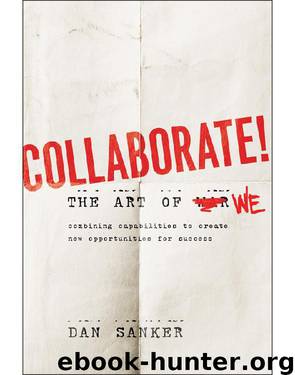Collaborate by Dan Sanker

Author:Dan Sanker
Language: eng
Format: mobi
Publisher: John Wiley & Sons, Ltd.
Published: 2011-12-13T23:00:00+00:00
Clarifies the goal and describes what needs to be done to achieve it
Assigns roles and responsibilities
Establishes a timeline
Identifies necessary resources
Describes the ways in which people will communicate and work together and how they will resolve conflicts
Conflict is an important part of the process, but it can be destructive instead of productive if the parties allow conflict to be focused on the people rather than on their ideas. To avoid conflicts that can end up tearing the group apart, all the parties need to discuss, understand, and be comfortable with their differences and commonalities, establish some ground rules, and decide on a process for handling conflicts when they occur. Plans should be realistic, flexible, and adaptable. Plans are likely to need adjustments as the group progresses toward its goal, but the basic framework has to be in place before work begins.
A Diverse Group
Diversity is the power behind collaboration. The Indian philosopher and environmental activist Vandana Shiva (1993) refers to the lack of diversity as a “monoculture of the mind” that reduces the number of perspectives and eliminates richness. The American journalist James Surowiecki (2004) has written about cognitive diversity that is achieved by choosing team members with differing backgrounds.
Without diversity, groupthink sets in. “Groupthink,” a term originally coined by business author and editor William Whyte, describes a behavior you may have seen or even been a part of—one in which members of a group avoid conflict and expedite consensus by choosing not to test, analyze, and evaluate ideas critically. The most well-known example is the 1957 film, Twelve Angry Men, which tells the story of a jury that is ready to come in with a guilty verdict without discussion, based on their personal assumptions and prejudices, when they are challenged to examine the facts by a single holdout (played by Henry Fonda).
“Unfortunately, groupthink isn’t just the stuff of compelling movies,” says Sharon Allen, chairman of the board of Deloitte LLP. In business organizations opportunities for groupthink abound, from the shop floor to the C-suite. Allen says the story illustrates the importance of being willing to “consider new ideas, ask tough questions and enable every voice in the room to be heard. . . . Historians have cited [groupthink] as a prime suspect behind a diverse array of events including Pearl Harbor, the space shuttle Challenger explosion, the dot-com meltdown, and the collapse of Enron.” Groupthink is often cited as a cause of the subprime mortgage debacle and financial crisis that triggered the recent Great Recession.
Yale research psychologist and UC Berkeley professor Irving Janis says that groupthink occurs “when the [group] members’ strivings for unanimity override their motivation to realistically appraise alternative courses of action” (Janis, 1972, pp. 8–9). Groupthink can lead people to set aside any doubts or concerns they may have and make decisions without critically testing, analyzing, and evaluating the options. Instead of engaging in the free and open discussion that is essential to collaboration, the group members yield to the temptation to minimize conflict and reach consensus or unanimity without adequately considering the alternatives.
Download
This site does not store any files on its server. We only index and link to content provided by other sites. Please contact the content providers to delete copyright contents if any and email us, we'll remove relevant links or contents immediately.
Hit Refresh by Satya Nadella(9040)
The Compound Effect by Darren Hardy(8817)
Change Your Questions, Change Your Life by Marilee Adams(7638)
Nudge - Improving Decisions about Health, Wealth, and Happiness by Thaler Sunstein(7622)
The Black Swan by Nassim Nicholas Taleb(7016)
Deep Work by Cal Newport(6887)
Daring Greatly by Brene Brown(6449)
Rich Dad Poor Dad by Robert T. Kiyosaki(6413)
Principles: Life and Work by Ray Dalio(6223)
Playing to Win_ How Strategy Really Works by A.G. Lafley & Roger L. Martin(5936)
Man-made Catastrophes and Risk Information Concealment by Dmitry Chernov & Didier Sornette(5925)
Digital Minimalism by Cal Newport;(5667)
Big Magic: Creative Living Beyond Fear by Elizabeth Gilbert(5616)
The Myth of the Strong Leader by Archie Brown(5429)
The Slight Edge by Jeff Olson(5353)
Discipline Equals Freedom by Jocko Willink(5288)
The Motivation Myth by Jeff Haden(5158)
Stone's Rules by Roger Stone(5027)
The Laws of Human Nature by Robert Greene(5003)
